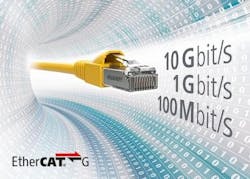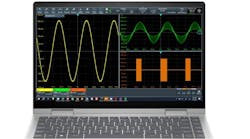EtherCAT G gigabit communication technology takes EtherCAT performance to the next level by delivering the Gbit Ethernet speeds needed to support highly data-intensive applications. The technology is compatible with the globally established 100 Mbit/s EtherCAT standard and also provides the same familiar ease of use. In addition, the branch controller model for EtherCAT G enables the efficient operation of multiple network segments in parallel.
EtherCAT G supports standard Ethernet transmission rates of 1 Gbit/s; its EtherCAT G10 counterpart, already introduced as a proof-of-concept technology study, is even faster with data rates of 10 Gbit/s. The sharp increase in transmission rates beyond the standard 100 Mbit/s provided by EtherCAT significantly increases the possible data throughput. With propagation delay times through devices as a limiting factor on the one hand, but boosted by the newly introduced branch model on the other, EtherCAT G can deliver a two-to-sevenfold performance increase, depending on the application.
Though it is not a substitute for standard EtherCAT, EtherCAT G shares the same characteristics, yet achieves even higher transmission speeds without changes to the protocol or the EtherCAT master software. Fully compatible with the globally established EtherCAT standard, EtherCAT G provides the same field-proven capabilities, including built-in diagnostics, high-precision synchronization, and, most importantly, unrivaled telegram processing on the fly. It also conforms to the IEEE 802.3 Ethernet standard.
EtherCAT G has been developed specifically in anticipation of extremely large-scale applications and greater use of highly data-intensive equipment, such as machine vision cameras, complex motion control systems and measurement equipment operating with high sampling rates. EtherCAT and EtherCAT G can be combined within a heterogeneous network. This means that EtherCAT G slaves can operate in a 100 Mbit/s EtherCAT network, and vice versa. In both instances, EtherCAT G equipment falls back to the 100 Mbit/s rate.
- flexible topology
- outstanding diagnostics
- synchronization accuracy better than 100 ns
- exceptionally simple configuration
- low system costs
- maximum performance
- ability to integrate functional safety
- IEEE-802.3 compliant





